|

THE HEART OF JAVANESE CULTURE
Visitors could gain access easily to the land of fascinating sights both natural and man made including the 8th century temples of Borobudur, Prambanan and countless other masterpieces of architecture such as The Karatons (Royal Palaces) in Jogyakarta and Surakarta. The inscriptions on stone, respectively of Canggal from 732 AD and of Balitung from 907 AD, indicated that between 750 and 900 AD, this region: The Kingdom of Mataram (nowadays the provinces of Yogyakarta and Central Java) were ruled by Hindu Sanjaya and Buddhist Cailendra dynasties. Borobudur was built by rulers of Cailendra dynasty whereas Prambanan by rulers of Sanjaya dynasty.
The People, generally very courteous and hospitable should gladly welcome all tourists domestic as well as foreign. The Javanese maintains a strong link with their own old centuries tradition - in culture, in art, and more importantly in their character and manner.
Politeness and good behavior are highly regarded. They are hard working, low-profile people who are very proud of their culture and tradition whilst eager to embrace the benefits of modernity, hold firmly to Javanese value. The people are very helpful, this is in accordance with their Principle of Society of Life i.e. MASYARAKAT GOTONG ROYONG : Mutual COOPERATION.
The captivating physical beauty of the nature, westward of the volatile mount Merapi, 40 km north west of the city of Jogyakarta
THE ANCIENT TEMPLES
Borobudur
The world's biggest Buddhist temple and the greatest ancient monument in the southern hemisphere stands peacefully in tranquility.
Borobudur is one of the seven wonders of the world. The shrine has nine square terraces and a circular top one, is ½ meters high covering a hillock overlooking the Southern Central Javanese plains, known as the Garden of Java.
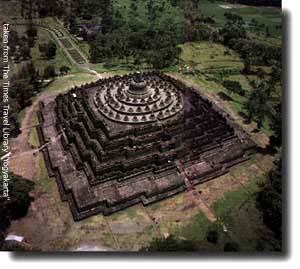
By turning left following the pilgrims' path to the summit which is 3 miles walk, is a symbolic journey through the three spheres of Mahayana Buddhism:
Kamadhatu - lower sphere of daily world
Rupadhatu - the world of form
Arupadathu - the higher sphere i.e. the world of formless : abstract state of heavenly perfection
The 1460 relief carving in stone slabs that cover the balustrade illustrating life of Buddha's teaching. The total statues of Buddha are 504.
On the upper, open terraces are more than 70 stupas, containing the sitting statues of Buddha. The form of Borobudur resembles a gigantic stupa, believed to be a structure to assist meditation. On the top, underneath the great stupa, alone under the sky, surrounded by the green plains far below, the sensation is one total release and serenity ..
Nearby Borobudur they are two other smaller Buddhist temples in perfect condition.
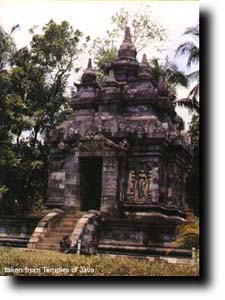
Pawon Temple
Tiny temple 2 km east of Borobudur, contains a Buddha statue. The temple's style and the reliefs carved on the wall resemble most Javanese Hindu Temple.
Mendut Temple
Located 1 km to the east of Pawon temple. Inside the temples there are magnificent statues of Buddha. For Waicak ceremony, the offering and the praying start in this temple.
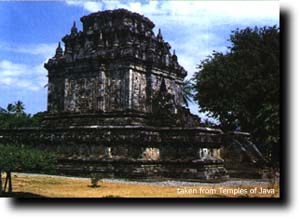
WAIÇAK
The ceremony commemorates the birth, death and enlightenment of Buddha, always held during a full moon (this, 1998 year shall be on May 12, 1998-Tuesday, starting in the evening at May 11, 1998 Monday).
The procession begin at Mendut led by Budhist SAFFRON - ROBED monks to Pawon then Borobudur (+/- 3 km walk), where candles are lit and flowers strewn about, followed by praying and chanting climaxes in the early morning when ten of thousands of worshippers (local and foreign) converge at the summit of Borobudur.
This is a real sacred and at the same time fantastic religious performance.
Note:
The holy water used in this ceremony is taken from sendang (pool) JUMPRIT nearby the town of Temanggung. A pool believed as having mystical power.
The fire is taken from everlasting natural source in the village of MERAPEN.
Prambanan
This is the most famous and also the most magnificent of Central Java's temples or more precisely complex of temples. Located in the sub-district of Prambanan on the border between Yogyakarta and Surakarta (17 km east of Yogyakarta or 40 km west of Surakarta). From this place looking to faraway through endless green rice terraces in the gigantic skyscraper Mount Merapi. The main spike soars 47 meters high and the temple is lavishly carved. The temple LORO JONGRANG (Prambanan) " The slender virgin" who according to legend was turned into stone by a giant she refused to marry.
The Candi (Temple) Loro Jongrang - Prambanan
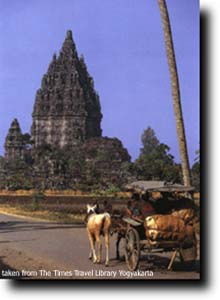 |
It is believed to be built by RAKAI PIKATAN to commemorate the glorious power of Sanjaya Hindu dynasty in the empire of MATARAM in the 8th and 9th century.
The largest is Shiva Temple - the showpiece - architecturally the most perfect. On the right and left sides of the main gate stands the guards statues Nandiswara and Mahakala.
Starting from the eastern entrance gate The Ramayana Legend carved inner site of the wall encircle the temple, telling the struggle of Lord Rama to free his wife Sinta, from an evil giant king - Rahvana.
|
In the main chamber, there is a huge statue of the four armed Shiva in his manifestation as Mahadewa. In the South chamber is Agastya as Shiva mahaguru divine-teacher, in the western chamber is the elephant - headed Ganesha - son of Shiva, in the north chamber is the statue of DURGA MAHESASURAMARDANI. Some believe that divine statues in fact are the image of the rulers of Sanjaya dynasty/HINDU MATARAM. Shiva was the Maharaja Balitung , the King Durga was Loro Jongrang/Princess PADMOWATI, Ganesha was their son, prince Daksotomo ; Agastya was the Patih (Chief Minister), Danghyang Samorosonto.
Vishnu Temple
This is smaller than Shiva temple, to the north of Shiva Temple, there is a statue of Vishnu and on the wall are reliefs of the story of Lord Khrisna.
Brahma Temple
It is located to the South of Shiva Temple, with a statue of four-headed Brahma, and relief carving of the final scene of the Ramayana.
Nandi Temple
It faces the Shiva temple. A statue of Nandi the bull of Shiva is inside flanked at the back with statues of God Surya and Goddess Candra on their chariots drawn by horses.
A & B Temples
Each measures 13 x 13 meters with 22 meters height : no statues inside.
Apit Temples
Two temples, each measures 6 x 6 meters with 16 meters height. On the side of entrance gate they are statues of lions.
Kelir Temples
There are four temples in the front of every entrance gate. The measure each is 1,55 x 1,55 meters with 4,10 meters height. They protect the sacred place from evil spirits.
Sudut or Corner Temple
Four small temples, each measures is 1,55 x 1,55 meters with 4,10 meters of height in every corner of the site.
Ramayana Ballet
It is performed under the full moon from May to October (dry season) on open stage with the back-drop of illuminated Loro Jongrang Temple. This dance drama performs by more than 200 dancers with gamelan music. It is dynamic and magnificent spectacle.
It should be a pity if visitors miss this performance, in that case an indoor dance is available during the daytime but of course less spectacular.
Sewu or Thousand Temples
Located 2 km north of Prambanan Temple. This is the second largest Buddhist Temple complex in Java, Restoration is professionally underway to reach its original form.
It is a MANDALA, manifesting the universe in the center temple of Mahadeva, surrounded by four rings of 250 smaller temples of Gods.
Plaosan Temples
The site is around 1 km east of Sewu Temples. These temples are unique combining Hindu and Buddhist symbols and carving.
Originally, they were three temples, the shrines and statues are very impressive. According to inscriptions on the stone of Plaosan, these temples were constructed jointly by the rulers of Sanjaya (Rakai Pikatan) and Cailendra (King Samaratungga) dynasties.
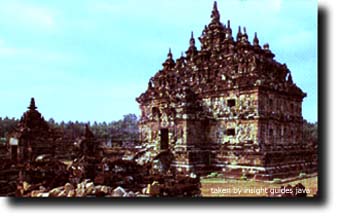
Sojiwan Temple
This Buddhist temple is located about 1 km from Prambanan on the road to Solo.
Karaton Ratu Boko
" The palace of the eternal Lord " is believed to be a Hindu palace complex built in 778 AD. It is located on the top of a hill 1 km South of Prambanan . Restoration is underway. The view from the top of the hill is splendid. The Prambanan Plains, the mount Merapi to the north, Yogya city, 18 km to the west are beautiful scenes in the bright sunny days.
Kalasan Temple
It is built in the Kalasan village about 2 km west of Prambanan, 15 km from Yogyakarta.
It is dedicated to a Buddhist Goddess, TARA. It is 6 meters tall and has 52 stupas.
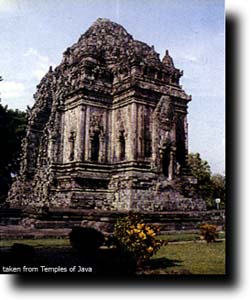
Sari Temple
It is nearby Kalasan Temple, 500 meters north of Kalasan. It is a small but elegant Buddhist temple.
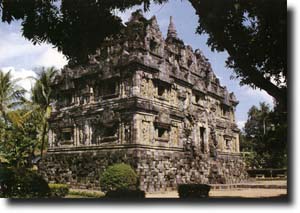
Gedong Songo Temple
There are nine Hindu Candis of 8th century A.D. on the slope of Mount Ungaran, South Semarang. The weather is always cool, the setting is superb, the view is magnificent, might be one of the most spectaculer views in Java. The candi's simple architecture are dedicated to SIVA and VISHNU, facing south is the shimmering Rawa Pening Lake, Mounts Merbabu and Merapi, to the west are Mounts Sumbing and Sindoro. The morning panorama is Breath-taking.
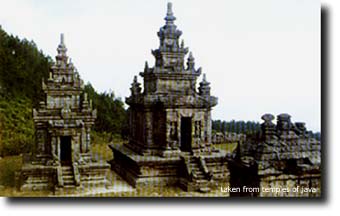
Sambisari Temple
It is a Shiva temple, discovered in 1966, located about 10 km from Yogyakarta. It was covered by volcanic ash and dust, 6 meters below the surface of surrounding land, but it is in perfectly condition.
The Temples of Dieng
Located at Dieng Plateau about 2600 meters above sea level. They are smaller Shiva temples, built by Sanjaya dynasty and named of wayang heroes such as Dwarawati, Bima, Arjuna, Puntadewa, Srikandi, Sembadra, and Semar.
Dieng plateau is about 150 km northwest of Yogyakarta. The name Dieng means Di-hyang " The abode of God ", centuries ago it was once the site of a temple - city of Hindu's priests. The plateau was formed many millennia ago by eruption of huge volcano, remains active up to now, the proof is the existence of working craters such as Sikidang, Sileri, Sikumbang, etc.
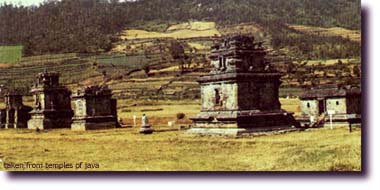
(Suryo S. Negoro)

|
